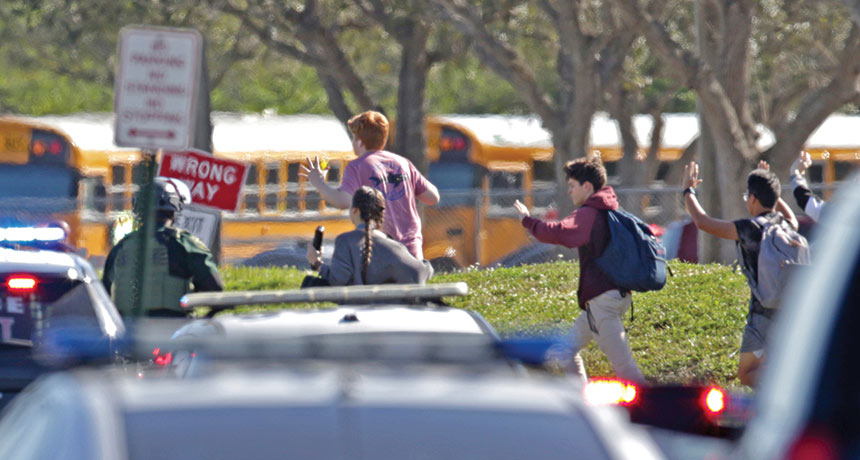Why science still can’t pinpoint a mass shooter in the making
Warning: Undefined array key 0 in /home/www/www.sknl.cn/wp-includes/media.php on line 779
Warning: Undefined array key 0 in /home/www/www.sknl.cn/wp-includes/media.php on line 785
Warning: Undefined array key 1 in /home/www/www.sknl.cn/wp-includes/media.php on line 785
Warning: Undefined array key 0 in /home/www/www.sknl.cn/wp-includes/media.php on line 787
Warning: Undefined array key 1 in /home/www/www.sknl.cn/wp-includes/media.php on line 787
Warning: Undefined array key 0 in /home/www/www.sknl.cn/wp-includes/media.php on line 790
Warning: Undefined array key 1 in /home/www/www.sknl.cn/wp-includes/media.php on line 790
Warning: Undefined array key 0 in /home/www/www.sknl.cn/wp-includes/media.php on line 779
Warning: Undefined array key 0 in /home/www/www.sknl.cn/wp-includes/media.php on line 785
Warning: Undefined array key 1 in /home/www/www.sknl.cn/wp-includes/media.php on line 785
Warning: Undefined array key 0 in /home/www/www.sknl.cn/wp-includes/media.php on line 787
Warning: Undefined array key 1 in /home/www/www.sknl.cn/wp-includes/media.php on line 787
Warning: Undefined array key 0 in /home/www/www.sknl.cn/wp-includes/media.php on line 790
Warning: Undefined array key 1 in /home/www/www.sknl.cn/wp-includes/media.php on line 790
Warning: Undefined array key 0 in /home/www/www.sknl.cn/wp-includes/media.php on line 779
Warning: Undefined array key 0 in /home/www/www.sknl.cn/wp-includes/media.php on line 785
Warning: Undefined array key 1 in /home/www/www.sknl.cn/wp-includes/media.php on line 785
Warning: Undefined array key 0 in /home/www/www.sknl.cn/wp-includes/media.php on line 787
Warning: Undefined array key 1 in /home/www/www.sknl.cn/wp-includes/media.php on line 787
Warning: Undefined array key 0 in /home/www/www.sknl.cn/wp-includes/media.php on line 790
Warning: Undefined array key 1 in /home/www/www.sknl.cn/wp-includes/media.php on line 790
Warning: Undefined array key 0 in /home/www/www.sknl.cn/wp-includes/media.php on line 811
Warning: Undefined array key 1 in /home/www/www.sknl.cn/wp-includes/media.php on line 811
Warning: Undefined array key 0 in /home/www/www.sknl.cn/wp-includes/media.php on line 70
Warning: Undefined array key 1 in /home/www/www.sknl.cn/wp-includes/media.php on line 71
Warning: Undefined array key 0 in /home/www/www.sknl.cn/wp-includes/media.php on line 70
Warning: Undefined array key 1 in /home/www/www.sknl.cn/wp-includes/media.php on line 71

Immediately after a 19-year-old shot and killed 17 people and wounded 17 others at a Florida high school on Valentine’s Day, people leaped to explain what had caused the latest mass slaughter.
By now, it’s a familiar drill: Too many readily available guns. Too much untreated mental illness. Too much warped masculinity. Don’t forget those shoot-’em-up video games and movies. Add (or repeat, with voice raised) your own favorite here.
Now the national debate has received an invigorated dose of activism. Inspired by students from the targeted Florida high school, as many as 500,000 people are expected to rally against gun violence and in favor of stricter gun laws on March 24 in Washington, D.C., with sister marches taking place in cities across the world. But a big problem haunts the justifiable outrage over massacres of innocents going about their daily affairs: Whatever we think we know about school shootings, or mass public shootings in general, is either sheer speculation or wrong. A science of mass shootings doesn’t exist.
“There is little good research on what are probably a host of problems contributing to mass violence,” says criminologist Grant Duwe of the Minnesota Department of Corrections in St. Paul. Duwe has spent more than two decades combing through federal crime records and newspaper accounts to track trends in mass killings.
Perhaps this dearth of data is no surprise. Research on any kind of gun violence gets little federal funding (SN Online: 3/9/18; SN: 5/14/16, p. 16). Criminologist James Alan Fox of Northeastern University in Boston has argued for more than 20 years that crime researchers mostly ignore mass shootings. Some of these researchers assume that whatever causes people to commit any form of murder explains mass shootings. Others regard mass killings as driven by severe mental disorders, thus falling outside the realm of crime studies.
When a research vacuum on a matter of public safety meets a 24-hour news cycle juiced up on national anguish, a thousand speculations bloom. “Everybody’s an expert on this issue, but we’re relying on anecdotes,” says sociologist Michael Rocque of Bates College in Lewiston, Maine.
Rocque and Duwe published a review of what’s known about reasons for mass public shootings, sometimes called rampage shootings, in the February Current Opinion in Psychology. Their conclusion: not much. Scientific ignorance on this issue is especially concerning given that Rocque and Duwe describe a slight, but not unprecedented, recent uptick in the national rate of rampage shootings.
Shooting stats
Defining mass public shootings to track their frequency is tricky. A consensus among researchers is emerging that these events occur in public places, include at least four people killed by gunshots within a 24-hour period and are not part of a robbery or any other separate crime, Rocque and Duwe say. Such incidents include workplace and school shootings.
Overall, mass public shootings are rare, Duwe says, though intense media coverage may suggest the opposite. Even less obvious is that rampage shootings have been occurring for at least 100 years.
Using Federal Bureau of Investigation homicide reports, Congressional Research Service data on mass shootings and online archives of news accounts about multiple murders, Duwe has tracked U.S. rates of mass public shootings from 1915 to 2017.
He has identified a total of 185 such events through 2017, 150 of which have occurred since 1966. (In 2016, he published results up to 2013 in the Wiley Handbook of the Psychology of Mass Shootings.) In the earliest known case, from 1915, a Georgia man shot five people dead in the street, after killing an attorney he blamed for financial losses, and wounded 32 others. Another lawyer, who came to the crime scene upon hearing gunshots and was wounded by a bullet, ended the rampage when he grabbed a pistol from a hardware store and killed the shooter.
What stands out more than a century later is that, contrary to popular opinion, mass public shooting rates have not ballooned to record highs. While the average rate of these crimes has increased since 2005, it’s currently no greater than rates for some earlier periods. Crime trends are usually calculated as rates per 100,000 people for, say, robberies and assaults. But because of the small number of mass public shootings, Duwe calculates annual rates per 100 million people in the United States.
The average annual rate of mass public shootings since 2010 is about 1.44 per 100 million people. That roughly equals the 1990s rate of 1.41, Duwe finds.
The average annual rate from 1988 to 1993 reached 1.52, about the same as the 1.51 rate from 2007 to 2012. After dropping to just below 1 per 100 million people in 2013 and 2014, rates increased to nearly 1.3 the next three years.
From 1994 to 2004, rates mostly hovered around 1 per 100 million people or below, but spiked to over 2.5 in 1999. That’s the year two teens killed 13 people at Columbine High School in Colorado.
In contrast, rates were minuscule from 1950 to 1965, when only three mass public shootings were recorded. The average annual rate for 1970 to 1979 reached 0.52, based on 13 mass public shootings.
Numbers of people killed and wounded per shooting incident have risen in the last decade, though. Two events in 2012 were particularly horrific. Shootings at a movie theater in Aurora, Colo., and an elementary school in Newtown, Conn., resulted in 40 murders, many of children, and 60 nonfatal gunshot wounds. Whether this trend reflects an increasing use of guns with large-capacity magazines or other factors “is up for grabs,” Duwe says.
The unknowns
No good evidence exists that either limiting or loosening gun access would reduce mass shootings, Rocque says. Virtually no research has examined whether a federal ban on assault weapons from 1994 to 2004 contributed to the relatively low rate of mass public shootings during that period. The same questions apply to concealed-carry laws, promoted as a way to deter rampage killers. As a gun owner and longtime hunter in his home state of Maine, Rocque calls for “an evidence-based movement” to establish links between gun laws and trends in mass shootings.
Mental illness also demands closer scrutiny, Duwe says. Of 160 mass public shooters from 1915 to 2013, about 60 percent had been assigned a psychiatric diagnosis or had shown signs of serious mental illness before the attack, Duwe has found. In general, mental illness is not linked to becoming violent. But, he says, many mass shooters are tormented and paranoid individuals who want to end their painful lives after evening the score with those they feel have wronged them.
Masculinity also regularly gets raised as a contributor to mass public shootings. It’s a plausible idea, since males committed all but one of the tragedies in Duwe’s review. Sociologist Michael Kimmel of Stony Brook University in New York contends that a sense of wounded masculinity as a result of various life failures inspires rage and even violence. But researchers have yet to examine how any facet of masculinity plays into school or workplace shootings, Rocque says.
Although school shooters often report feeling a desperate need to make up for having been inadequate as men, many factors contribute to their actions, argues clinical psychologist Peter Langman. Based in Allentown, Pa., Langman has interviewed and profiled several dozen school shooters in the United States and other countries.
He divides perpetrators into three psychological categories: psychopathic (lacking empathy and concern for others), psychotic (experiencing paranoid delusions, hearing voices and having poor social skills) and traumatized (coming from families marked by drug addiction, sexual abuse and other severe problems).
But only a few of the millions of people who qualify for those categories translate their personal demons into killing sprees. Any formula to tag mass shooters in the making will inevitably round up lots of people who would never pose a deadly threat.
“There is no good evidence on what differentiates a bitter, aggrieved man from a bitter, aggrieved and dangerous man,” says psychologist Benjamin Winegard of Carroll College in Helena, Mont.
Nor does any published evidence support claims that being a bully or a victim of bullying, or watching violent video games and movies, leads to mass public shootings, Winegard contends. Bullying affects a disturbingly high proportion of youngsters and has been linked to later anxiety and depression (SN: 5/30/15, p. 12) but not to later violence. In laboratory studies, youngsters who play violent computer games or watch violent videos generally don’t become more aggressive or violent in experimental situations. Investigators have found that some school shooters, including the Newtown perpetrator, preferred playing nonviolent video games, Winegard says.
He and a colleague presented this evidence in the Wiley Handbook of the Psychology of Mass Shootings. Northeastern’s Fox also coauthored a chapter in that publication.
Still, a small but tragic group of kids lead lives that somehow turn them into killers of classmates or random strangers (SN: 5/27/06, p. 328). If some precise mix of, say, early brain damage, social ineptitude, paranoia and fury over life’s unfair twists cooks up mass killers, scientists don’t know the toxic recipe. And it won’t be easy to come up with one given the small number of mass public shooters to study.
Duwe recommends that researchers first do a better job of documenting the backgrounds of individual mass shooters and any events or experiences that may have precipitated their deadly actions. Then investigators can address broader social influences on mass shootings, including gun legislation and media coverage.
But more than a century after a distraught Georgia man mowed down six of his fellow citizens, research on mass violence still takes a backseat to public fear and outrage. “If we’re bemoaning the state of research,” Duwe says, “we have no one to blame but ourselves.”
